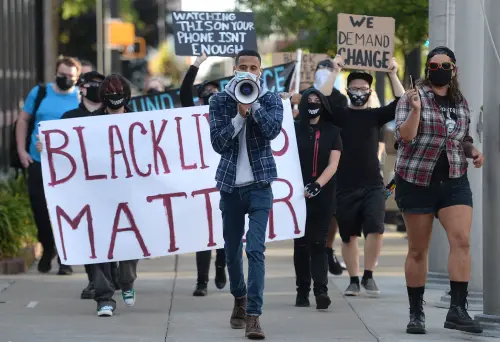How do members of racial minority groups view public education in the U.S.? This question is important, given both the widely recognized achievement gap between white students and students of color, as well as systematic differences in public schools by neighborhoods—differences which strongly correlate with income and race. Yet, public opinion polls typically do not offer detail on racial differences in opinions of local public schools.
We know from nationally representative surveys that the average American tends to view their local public schools in a positive light. The 2017 PDK Poll of the Public’s Attitudes Toward the Public Schools finds that nearly half (45 percent) of Americans give public schools in their community an A or B grade, with many fewer giving such grades to public schools nationally. This is a long-running trend, with other surveys finding similar results. Among those polls that do provide racial differences in opinion, the findings are usually limited to black-white differences only.
With a new survey conducted by NPR, the Robert Wood Johnson Foundation, and the Harvard T.H. Chan School of Public Healthwe can take a deep dive into perceptions about the quality of public schools among both whites and multiple racial and ethnic minorities.[1] The NPR/RWJF/Harvard survey includes nationally representative samples of white, African-American, Asian-American, Native American, and Latino respondents. As a result, this survey offers rare and valuable insights into perceptions about public education among racial minorities in the United States.
One of the most striking themes that emerges from the survey is the difference between how whites and African-Americans, Native Americans, and Latinos view public K-12 education. Consider Figure 1 below, which shows respondents’ answers to the following question: “Because of the way the schools operate where I live, (respondent’s own racial/ethnic identity) children here don’t have the same chances to get a quality education as white children.” This figure also reports the degree to which white respondents agree with the corresponding statement: “Because of the way the schools operate where I live, white children here don’t have the same chances to get a quality education as racial and ethnic minority children.”
The differences between whites and Asian-Americans, on the one hand, and African-Americans, Native Americans, and Latinos, on the other, is striking. Only 12 percent of white respondents agree that white children don’t have the same chances to get a quality education as racial and ethnic minority children. In contrast, 64 percent of African-Americans, 45 percent of Latinos, and 40 percent of Native Americans agree that children in their own racial or ethnic group don’t have the same chances to get a quality education as white children. While many African-Americans, Latinos, and Native Americans see their children as disadvantaged by the school system as a consequence of their race or ethnicity, most white Americans and Asian-Americans do not share this concern.
Figure 2 shows that Americans of different races and ethnicities also have different perceptions of how their local schools compare to schools in other neighborhoods. Respondents were asked, “Compared to other places to live, do you think the quality of public schools where you live is better, worse, or about the same as other places to live?”
While a plurality of each group (except Asian-Americans) says the quality of local public schools is “about the same” as in other places to live, there are distinct racial differences in explicitly positive or negative evaluations of local schools. Nearly a third (31 percent) of African-Americans and exactly a quarter of Native Americans think the quality of public schools is worse where they live than elsewhere, while only 17 percent of whites, 12 percent of Asian-Americans, and 11 percent of Latinos think this is the case.
Asian-Americans are the most likely (44 percent) to say the quality of their local public schools is “better” than in other places to live, compared to 38 percent of Latinos and 35 percent of whites. Only 20 percent of both African-Americans and Native Americans say the quality of their public schools is better than in other neighborhoods.
Furthermore, African-Americans’ perceptions of public school quality vary depending on whether or not respondents live in a majority-black neighborhood. Among African-Americans who say they live in a majority-black neighborhood, only 8 percent say that the quality of public schools is better where they live. African-Americans living in nonmajority-black neighborhoods are more than three times more likely (26 percent) to say the quality of their local public schools is better than in other places to live.
These findings seem to reflect the consequences of residential segregation and income inequality by race: High-income neighborhoods are more likely to be majority-white, and public schools in these neighborhoods are, on average, higher performing than their counterparts in low-income, majority nonwhite neighborhoods.
Differences between whites and African-Americans are also evident in the context of higher education. Figure 3 shows, among those who have ever applied to or attended college, the percent of each racial or ethnic group that say they have ever been personally discriminated against because of their race or ethnicity.[2]
Compared to whites, a higher percentage of each minority group surveyed reports personally experiencing discrimination in higher education, though in some cases only by a small margin. However, the rate is noticeably high among African-Americans: 36 percent of African-Americans report having personally experienced discrimination in this context, compared to 11 percent of whites.
Additionally, there are important racial and ethnic differences in whether people had ever applied for or attended college. While roughly two-thirds or more of African-Americans (65 percent), whites (66 percent), and Asian-Americans (72 percent) say they have applied for or attended college, only about half of Native Americans (53 percent) and Latinos (49 percent) have done so.
This gap is likely due in part to this additional finding from the survey: Respondents were asked whether, while growing up, they were encouraged to apply for college, discouraged from applying, or if applying to college was simply never discussed. As Figure 4 shows, for roughly half of Latinos (52 percent) and Native Americans (49 percent), applying to college was simply never discussed. In comparison, fewer than one-third of African-Americans (32 percent), whites (31 percent), and Asian-Americans (29 percent) report this.
In short, these survey results suggest that many people of color in the U.S. perceive fundamental inequalities within the public school system, as well as in their personal experiences with education. This is particularly the case for African-Americans and Native Americans, both groups that have experienced systemic discrimination at various points in American history.
We see a different story for Latino respondents. While a large share of Latino respondents believe their local schools do not allow their children the same chances for a quality education as for white children, Latinos also tend to believe that their local public schools are better than in other neighborhoods. Latino respondents may be satisfied with their own local schools while still perceiving barriers their children face when compared to white children. When it comes to personal experiences, Latinos are less likely to say they have personally been discriminated against while in or applying to college, but more likely to say that applying to college was not discussed while they were growing up.
These results highlight important differences in perspectives and experiences across racial and ethnic groups that are not often part of the conversation when we talk about the average American’s relationship to public education. This omission stems at least in part from choices about survey design. Surveys that do not over-sample respondents from minority groups will likely not have a sample large enough to reliably report on the views of these groups. Yet, if public policymakers primarily draw on data about the perspectives of “the average American” with respect to public schools, they will miss important differences in perspective among their constituents, particularly along racial and demographic lines.
To address this problem, researchers could design surveys that over-sample respondents from different minority groups, allowing for a better understanding of the diversity of viewpoints that are evident within the country. Researchers might also include a question at the end of a survey that asks respondents if, from their perspective, the survey omitted relevant issues. From these responses, researchers can incorporate questions that more accurately reflect and help us measure perspectives held by members of different minority groups. We also encourage researchers to reflect on the representation of views and identities among their own research team and work environment.
Moving forward, policymakers and researchers alike should pay more attention to the perspectives and experiences of minority groups, not only “the average American.”
Footnotes
- Dr. Logan Casey is a Research Associate in Public Opinion at the Harvard Opinion Research Program, and the deputy director of the “Discrimination in America” polling series, which is the source of the data discussed in this post. The polling series is based on a survey conducted for National Public Radio, the Robert Wood Johnson Foundation, and Harvard T.H. Chan School of Public Health.
- As with other forms of self-reported data, these findings rely on respondents’ perceptions. While the causes of these experiences could be related to other factors, the fact that respondents believe they are due to discrimination is significant.







Commentary
New survey of minorities adds dissenting view to public satisfaction with schools
January 11, 2018